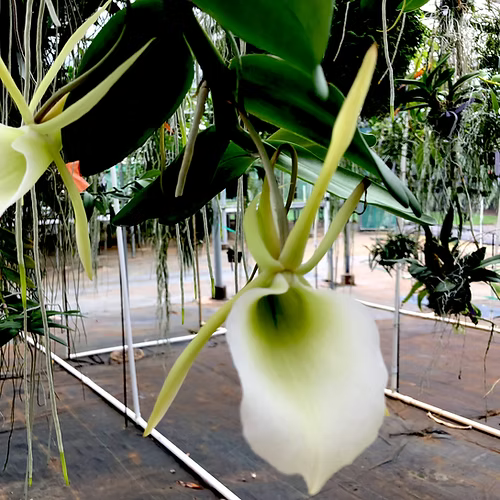Pronounciation: an-GRAY-kum
-
Light
Angraecum are grown similarly to phalaenopsis, they welcome light received from a North window or ambient light in a greenhouse, with up to 4 hours of direct sunlight. In a greenhouse, use shade cloth to reach 1000-2000 foot-candles. In the home, an East, North, or West window where they will get 1-4 hours direct sunlight are ideal.
-
Temperature
In general, angraecum are happiest at intermediate-warm temperatures between 70F-85F during the day, with a low of 55F at nightime. If growing indoors, typical room temperature works well!
-
Water
Angraecum, like most orchids, like quick wet/dry cycles. Let the media dry between watering, but water as soon as the media dries. If in a greenhouse, angraecum should be watered daily especially if mounted. Indoors, grow them potted and water from the top, watering when the media just dries.
Do not let water collect in the crown - water sitting in the crown promotes crown rot.
Never use ice to water orchids!
-
Humidity
Indoors, angraecum orchids will do well when they are well watered and frequently watered and humidity will not play a huge part in growing them successfully. If the watering is more infrequent, or the plant is mounted, humidity should be kept between 55% - 85%. Airflow in the environment is very important, supply consistent air movement around the plant especially when humidity is high or plants are grown in a greenhouse.
-
Fertilizing
Fertilize and water regularly in the growing seasons. A regular strength, high nitrogen formula (i.e. 30-10-10) used at 1/4 to 1/2 strength is recommended during growing seasons, but should be stopped completely in winter.
-
Repotting
Springtime is the best time to repot angraecum, immediately after flowering. It's important for angraecum to not disturb their roots too much. When repotting, lean the plant forward about 45 degrees or more. This prevents the roots growing upwards looking for media to grab onto, as the plants grow forward and lean off branches in their natural habitats.
Pot angraecum in a porous mix, such as bark mixture with pumice and charcoal, or mount them onto neutral media, and repot every 2 to 3 years or when media is breaking down.

